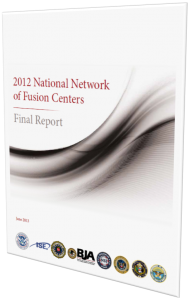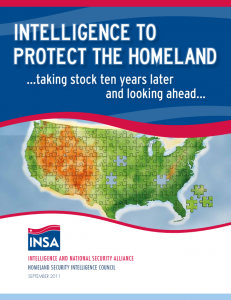intelligence
01.08.2013
Budget, fusion center, homeland security intelligence, Information sharing, intelligence, intelligence center, Performance Measures, Strategy, Uncategorized
 The Department of Homeland Security (DHS) released its 2012 National Network of Fusion Centers Assessment Report and the results are encouraging. DHS reported that (overall) fusion centers improved their capability scores by 11 points over the 2011 assessment report card. Summary findings, based on Critical Operating Capabilities (COCs):
The Department of Homeland Security (DHS) released its 2012 National Network of Fusion Centers Assessment Report and the results are encouraging. DHS reported that (overall) fusion centers improved their capability scores by 11 points over the 2011 assessment report card. Summary findings, based on Critical Operating Capabilities (COCs):
COC 1 – Receive
- All fusion centers (77 or 100%) have access to federally sponsored Sensitive But Unclassified (SBU) information sharing systems.
- Every fusion center (77 or 100%) has at least one person cleared to access Secret information, but regular staff turnover means that fusion centers will continue to request new clearances (approximately 500 new clearance requests in the next 12 months).
- A significant number of fusion centers have on-site access to classified information sharing systems (66 or 85.7%).
- Fusion center use of the DHS Secret Internet Protocol Router Network (SIPRNet) Whitelist (Whitelist) is limited (41 or 53.2%).
COC2 – Analyze
- Fusion centers are highly involved in assessing threat and risk for their area of responsibility (AOR) (72 or 93.5%).
- Fusion centers are obtaining and using customer feedback on their analytic products (structured feedback: 65 or 84.4%).
- Analytic production plans are used widely across the National Network (60 or 77.9%).
- Critical infrastructure protection capabilities continue to expand across the National Network (75 or 97.4%).
COC 3 – Disseminate
- Despite progress since 2011, less than half (35 or 45.5%) of the National Network have a process in place to verify that customers are receiving their products.
- Fusion centers are increasingly designating a single, primary information sharing system (72 or 93.5%), but Homeland Security Information Network (HSIN) Intel is not frequently cited (23 or 29.9%) as the primary system for unclassified communication between fusion centers.
COC 4 – Gather
- The number of fusion centers that have developed Standing Information Needs (SINs) has increased (59 or 76.6%), but continued attention to SINs development is necessary.
- The National Network has a robust request for information (RFI) management capability (69 or 89.6%).
- A significant percentage of the National Network are involved in the Nationwide Suspicious Activity Reporting (SAR) Initiative (NSI), in particular in providing line officers with information on the behaviors identified in the Information Sharing Environment (ISE)-SAR Functional Standard (SAR line officer training: 66 or 85.7%).
DHS has identified three areas for improving fision center capabilities:
- Use Standing Information Needs (SINs) as the foundation of a customer-driven fusion process:
Fusion centers need to have a process for a) deriving and cataloguing regional and federal information and intelligence needs SINs , and b) actively tagging/associating these SINs with the information and intelligence products they produce.
- Document key business processes and ensure consistent access to training:
High turnover in critical fusion center staff positions is going to be the norm, for a number of reasons – staff rotations, augmentation, contract renewals, promotions, etc. Fusion Center Directors must plan for this “churn” by taking the time to a) document the center’s core business processes, b) keep SOPs and policies up to date, and c) develop training and other performance support tools to minimize the impact of staff turnover on center operations.
- Implement organizational planning and evaluation processes to continuously improve fusion center operations:
Fusion centers should clearly develop and communicate their center’s mission, goals, and objectives by developing a strategic plan, and using that plan as a tool to measure its performance. The strategic plan and periodic performance reports should help to communicate how investments in the fusion center result in tangible results, and b) help to drive annual budget requests to sustain or enhance current center capabilities.
I see gaps in these areas in my own work with fusion centers…unfortunately, many fusion centers are so busy with operational activities, that developing SOPs, training, strategic plans, etc., ends up on the back burner.
One other area, not directly addressed by the DHS assessment process is the development of an effective plan and roadmap for building an IT infrastructure that supports the four COCs. This too gets relegated to the back burner. In some cases, IT is addressed, but in a piecemeal fashion – Fusion Center Directors should elevate the need for an integrated IT plan, one developed from Fusion Center business processes and describes three key areas.
Suggested Components of a Fusion Center IT Strategy
- Information and Intelligence exchanges – what information, data, and intelligence comes-in and goes-out of the Fusion Center?
- What functional capabilities does the Fusion Center have now and which systems deliver those capabilities? (as-is)
- What NEW functional capabilities does the Fusion Center need, and how will the center procure them? (to-be)
- How much money does the Fusion Center need to a) sustain current capabilities and b) to implement the new capabilities?
Feel free to reach out to me if your center would like to discuss enhancing your operational and/or IT planning capability.
r/Chuck
05.06.2012
Information sharing, intelligence, law enforcement, social media
 I have always thought that Private Investigators were sleazy peeping toms who spied on others to make money catching people in compromising positions—very useful if you’re the wife of a philandering jerk.
I have always thought that Private Investigators were sleazy peeping toms who spied on others to make money catching people in compromising positions—very useful if you’re the wife of a philandering jerk.
Boy was I off the mark. I attended a presentation by Michele Stuart, an Investigator with her own company, JAG Investigations, Inc in Arizona. From the moment she started her presentation, we were on the edge of our seats. For about 40 minutes, she made us all sit up and listen to what she had to tell us about the challenges and tools of using the internet to conduct investigations and to share with us her impressive knowledge of public records and on-line databases.
With over 18 years of investigative experience behind her, Michele knew a lot about websites that rob your personal information, how to find someone on the internet, and many more informative pieces of information that would help those who use the internet to find people.
As an example, she launched her presentation with “who owns an android phone”, as several of us raised our hands. Followed with “and do you have the flashlight app installed on your androids”? To which several of us (including me!) left our hands up. Apparently by downloading flashlight, and by agreeing to the terms and conditions, we are allowing this little app to secretly take video (and audio), see what numbers we are calling, and many other things you wouldn’t normally think a flashlight app should do. I suddenly felt my phone was ‘dirty’ and I uninstalled flashlight there and then – for more information, take a look here – http://itunes.apple.com/gb/app/flashlight./id285281827
Michele also warned us of websites that can do harm to our personal information, and websites that will create fake identities like your virtual buddy, which you can set to ring you and possibly get you away from where you don’t want to be by pretending it’s your friend calling and wants to meet you urgently. A great excuse when you do need to leave without appearing rude. She also told us the best sites to find old addresses, and how to find people you have lost touch with.
Of all the sessions I attended at LEIM, Michele’s was the most entertaining. Her quick fire delivery, rarely pausing for breath, as she just wanted to tell us all she could in her allotted time slot. And tell us she did with much passion and plenty of humor, it was pure entertraining (entertaining training). I will certainly keep her business card handy; I may need her help one day.
Some websites Michele mentioned:
www.jaginvestigations.com – Michele’s Company
http://alibinetwork.com – creates fake identifications
http://www.networksolutions.com/ – here you can find old addresses and email addresses by searching domain names.
r/Mary
11.09.2011
Analysis, homeland security intelligence, INSA, intelligence
 Today is the ten-year anniversary of 9/11/2001. As we honor the sacrifies of those who perished in the horrible events of that day, we must remember that it is is really what we do EVERY DAY that will help to prevent future attacks on our soil, or the soil of our friends and allies. At the heart of issue is “homeland security intelligence”…the information and data that we will need to deter, detect, and disrupt the activities of those to wish us harm.
Today is the ten-year anniversary of 9/11/2001. As we honor the sacrifies of those who perished in the horrible events of that day, we must remember that it is is really what we do EVERY DAY that will help to prevent future attacks on our soil, or the soil of our friends and allies. At the heart of issue is “homeland security intelligence”…the information and data that we will need to deter, detect, and disrupt the activities of those to wish us harm.
On September 7, 2011, the Intelligence and National Security Alliance’s (INSA) Homeland Security Intelligence Council (HSIC) released a white paper proposing significant recommendations for Homeland Security Intelligence. The white paper, entitled “Intelligence to Protect the Homeland: Taking stock ten years later and looking ahead,” examines what has been learned in the last ten years and what will be needed from the intelligence community to protect the homeland from future attacks. My friend and colleague Joe Rozek, who chairs the INSA Homeland Security Intelligence Council, commented:
“The HSIC has worked tirelessly for months and today we are proud to offer our analysis and recommendations to the intelligence and homeland security communities on the 10 year anniversary of September 11th, Homeland Security Intelligence is a discipline that will depend on the successful fusion of foreign and domestic intelligence to produce the kind of actionable intelligence to protect the homeland. Yet, underpinning our analysis is the foundational principle that respect for privacy and civil liberties is an inherent, inseparable part of our national security and core values as a nation.”
The major recommendations in the HSIC white paper include:
- Adopting a common definition for Homeland Security Intelligence (HSI) to better facilitate its collection, analysis, and use in decision making, as well as development as a discipline;
- Departing from the “command and control” or top-down hierarchical model and moving toward an integrated enterprise characterized by coordination of intelligence and analysis efforts among federal, state, local, tribal law enforcement and intelligence agencies;
- As appropriate, bringing select private sector partners into the enterprise; and
- Ensuring the protection of Americans’ privacy and civil liberties through widely applicable training and accountability standards to ensure lawful and aggressive detection and deterrence of terrorist operations in the U.S.
Take some time to read this white paper and I’d be interested in your comments and thoughts…r/Chuck
 The Department of Homeland Security (DHS) released its 2012 National Network of Fusion Centers Assessment Report and the results are encouraging. DHS reported that (overall) fusion centers improved their capability scores by 11 points over the 2011 assessment report card. Summary findings, based on Critical Operating Capabilities (COCs):
The Department of Homeland Security (DHS) released its 2012 National Network of Fusion Centers Assessment Report and the results are encouraging. DHS reported that (overall) fusion centers improved their capability scores by 11 points over the 2011 assessment report card. Summary findings, based on Critical Operating Capabilities (COCs): I have always thought that Private Investigators were sleazy peeping toms who spied on others to make money catching people in compromising positions—very useful if you’re the wife of a philandering jerk.
I have always thought that Private Investigators were sleazy peeping toms who spied on others to make money catching people in compromising positions—very useful if you’re the wife of a philandering jerk.